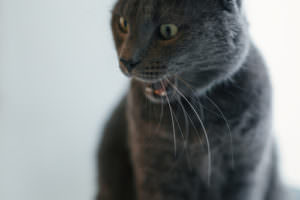
Clawing is a normal behavior for cats that we must try to channel and can never truly eliminate. Most owners think that cats scratch to sharpen their claws, but the behavior is much more than that.
According to the Handbook of Behavior Problems of the Dog and Cat, (Elsevier 2003) scratching behavior maintains claw health and is also a form of visual and pheromonal (hormone) marking. A sign or signal to other cats or animals of things like territory boundaries.
Cats produce a marking chemical between their toes (interdigital semiochemical) that they can release when they scratch. Studies have shown that when scratching posts are treated with a synthetic version of this chemical, cats will select the treated posts more frequently. This study proves that the chemical is perceptible to the cats and is effective as a marker to other felines. (Journal of Feline Medicine and Surgery, Oct 2013)
The veterinary industry is trying to maximize what we are learning about cats to produce readily available chemical substitutes to help human care givers channel their natural tendencies, but there is much to learn about these fascinating animals.
There are other things that you can do to help guide your cat to choices that you are happier with. They seem to favor vertical surfaces that are covered with a rough material that they can hook their claws into so they can stretch their front legs. Stretching seems most common when waking, so placing these desirable objects near resting places would be a good plan to help direct the behavior. If you need to try to redirect your cat’s scratching behavior, you should try different types of posts and surfaces.
If your cat is choosing a less desirable area to scratch, you can discourage the less appropriate place by making it aversive to the cat, maybe with crinkly paper nearby or by spraying him with water in spray bottle hidden close by. It won’t take much consistently undesirable stimuli to persuade your cat to go elsewhere (as long as you provide a pleasing option).
Clawing objects is instinctive to cats. Fortunately we can train and direct the behavior so that we can co-exist happily. Just as I mentioned in my article, Does My Dog Know He’s Been Bad, animals care about us, but not our possessions. Your cat thinks she is showing the world that your recliner is her territory. She does not see her behavior as damaging. To her, she is improving it!
 About The Vet: Dr. Kathryn Primm is small animal veterinarian. She owns a busy practice in Tennessee and loves sharing all kinds of animal facts and fun. She has consulted on articles for national magazines, done numerous radio interviews and appeared on local television. She has contributed to an article for Woman’s Day in Feb 2014 and a piece for Prevention magazine in April 2015.
About The Vet: Dr. Kathryn Primm is small animal veterinarian. She owns a busy practice in Tennessee and loves sharing all kinds of animal facts and fun. She has consulted on articles for national magazines, done numerous radio interviews and appeared on local television. She has contributed to an article for Woman’s Day in Feb 2014 and a piece for Prevention magazine in April 2015.
She has a social media presence on Twitter, Facebook and Google+ and enjoys interaction with others about her passions, animals and communication. She is a regular contributor to Boomeon, the online community which can be found at www.boomeon.com. She has also written a book, Tennessee Tails:Pets and Their People. The book received recognition as Runner Up in the Memoirs category at a national book festival. You can read more about Dr. Primm and how to get the best value for your pet care dollar at her website, www.drprimm.com.

